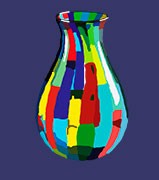
Murano Island of Venice is famous for the Venetian Murano glass and is one of the most visited islands of the city. Hundreds or even thousands of tourists visit it each day eager to take a stroll among numerous Venetian glass stores, cafes and restaurants. Also, here you will be able to visit glass factories and learn about the production of Murano glass that has managed to win the hearts of people around the world for centuries now.
Murano is one of numerous islands in the Venice lagoon that is located north of the historical center of Venice. Today it is one of the best known islands among tourists, who usually dedicate one or more days for just visiting the islands of the Venetian lagoon. Murano Island, as most islands of Venice, is composed of seven small islands that are interconnected by bridges and divided by canals.
It is believed that the Island of Murano was populated at the same time as the rest of Venice. However, it was first mentioned in the written documents only in the 9th century. Even though just around two kilometers from the historic center of Venice, the island of Murano enjoyed the right to elect their own laws and to even have its own currency. The island lost its autonomy only in 1923, when it became a part of Venice.
Actually, according to most, the island of Murano is not the prettiest island of the Venetian lagoon, but it is still a very important tourist attraction. First of all, world famous Murano glass draws its origins from here but there are also other important features.
Attractions of Murano Island:
Murano Glass factories- there are still numerous small factories that make the glass on the island. It is important to know that some of these factories can be visited free of charge. During the visit you will have the chance to see how the local artisans work the glass and learn more about Murano glass.
Murano glass museum- There is a museum dedicated to Murano glass. In this museum visitors will have the chance to get to know more about glassmaking in the Roman period and see the collection of Murano glass from the 13th to the 20th century.
Murano lighthouse- Even though there was a lighthouse on the island for centuries, the version that you can see today is from more modern times. At first an iron lighthouse was built in 1912, but was soon replaced by the lighthouse made of Istria stone in 1934.
Murano Glass
 The legend of Murano glass starts in 1291 when it was decided that the glass furnaces from Venice should be moved to the island of Murano. Even though before this event Venice had had a long history of producing glass (it is believed it started before 1,000) the whole production was moved to Murano. The reason was that most of the buildings in Venice were made of wood, and glass furnaces in this period were responsible for numerous fires that threatened the whole city.
The legend of Murano glass starts in 1291 when it was decided that the glass furnaces from Venice should be moved to the island of Murano. Even though before this event Venice had had a long history of producing glass (it is believed it started before 1,000) the whole production was moved to Murano. The reason was that most of the buildings in Venice were made of wood, and glass furnaces in this period were responsible for numerous fires that threatened the whole city.
Also, as a consequence of moving the glass production to Murano, Venice was able to control the glassmaking and hide it from the curious eyes. To what extent Venice tried to preserve glass production testifies the fact that glassmakers could not leave the island of Murano unless with a special permit. Even though obligated to live on the island and almost never leave, some glassmakers managed to escape and spread the knowledge of glassmaking in other countries.
To how important the glass production was for Venice also testifies the fact that only master glassmakers were allowed to marry into noble families in the Venetian Republic.
Interesting facts